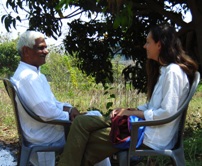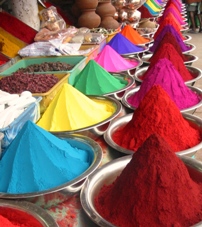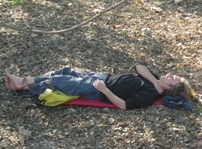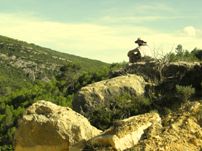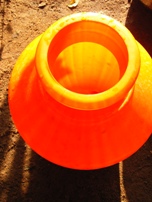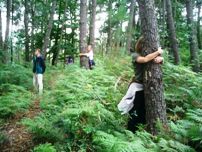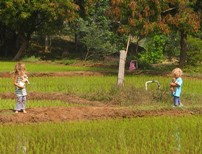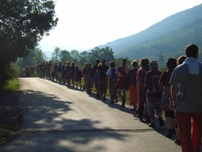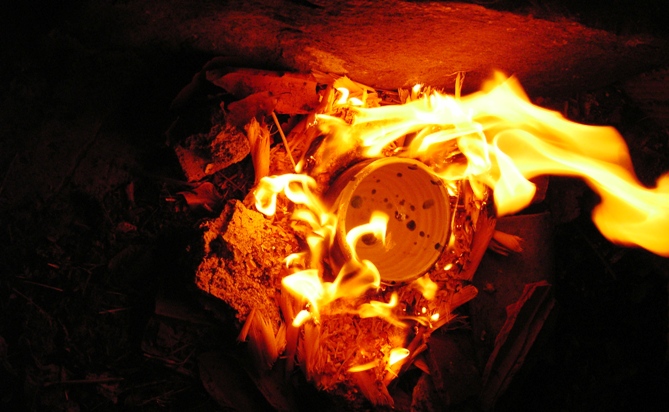
Open Dharma offers varied retreat forms because no one format can meet the needs of everyone. Some people may need an afternoon and others several months, to dive into their own aliveness. Someone may need deep silence at one time and, at another time, the chance to integrate music and inner silence. We love to experiment with new ways of exploring the vastness of Dharma, and especially to bring depth and clarity into situations usually considered “ordinary,” such as conversation, family life, or work. Jin Shin Jyutsu, nature, communication, family, and creativity can bring flow, playfulness, humility, and joy, when silent stillness somehow gets confused for heaviness or seriousness. At the same time, resting in the silence of formal meditation helps illuminate the real meaning or freedom in Jin Shin, nature, communication, family, and creativity.
~ Ongoing teachings
Keeping momentum in spiritual practice is so important that Open Dharma tries to offer as much continuity of support as possible, despite limited resources. Tragically, it is common practice to attend occasional intensive retreats, with decreasing enthusiasm for tending the garden of spiritual life after retreat. Often we think that we “should” be able to keep the garden flourishing, no matter what desert-like circumstances we live in. And when the garden dries up, we blame ourselves, our techniques, our parents, or our facilitators. It is as if a gardener blames the trees, the watering hose, herself or himself, and the earth for the fact that not enough water was given. We urgently need to surround ourselves with enough spiritual culture to help us grow the garden to fruition—to remind us to irrigate if it has not rained.
Open Dharma teachers regularly offer loosely structured teachings between retreats. In Lucknow, India, Open Dharma has occasionally offered open retreats, a Jin Shin Jyutsu retreat, yoga classes, and facilitated group discussions. Participants may request interviews with the teachers.
All teachers intend to offer live teachings via internet in the near future.
~ Jin Shin Jyutsu® retreats
When we suggest that one can simply hold any finger of either hand during a meditation,
we often hear the surprised delight afterwards of those who tried it: “Why didn’t anyone
tell me this years ago?”
Jin means “human being;” Shin means “spirit, heart, or god;” and Jaya likes to translate the word
Jyutsu as improvisation, games, or art. One of the most graceful Jin Shin Jyutsu games is
simply to relax the shoulders and “smile or be as you are.” Both Jin Shin Jyutsu and
meditation practices empower us to improvise harmony of the human and the divine in life.
Silence, meditation, and the simple mudra (hand positions) of Jin Shin Jyutsu work together
synergistically. Those who are familiar with Jin Shin often find their way deeper into the
core of this art in a silent retreat setting. Those who are new to Jin Shin are usually
amazed at how much simple hand positions help us relax into simplicity and the deep being
of meditation.
Some Jin Shin retreats focus on applying this harmonizing art on oneself, and some
retreats include the opportunity to exchange treatments with others. One of the things
we love best about Jin Shin is that beginners are as free to offer treatments as
experienced practitioners. Mary Burmeister, who brought the art from Japan to the US
in the 20th century, used to say, “The only mistake in Jin Shin Jyutsu is not to
offer it.”
For official Jin Shin Jyutsu information and course schedules, please see the website:
www.jinshinjyutsu.com
For more information about Jin Shin Jyutsu, click here.
~ Individual and longer retreats
Some people come to a spiritual ripeness where they need to enter fully into their own individual rhythm, with some support and encouragement from facilitators. Open Dharma wishes to offer the space for a few people to dive into this experiment of solitude, integration, and depth. Individual retreats usually include some work meditation to ground the inner life. Longer retreats of several weeks or months also allow individuals great freedom to unveil and explore their own unique paths, while also enjoying the momentum and atmosphere of group practice.
~ Awakening with horses
Awakening with horses is first of all a program based on the basic beauty of seeing horses in nature and being surrounded by them.
From this simple being, we find a way to interact with them in a respectful horse-based body language.
Furthermore we let the horses be a mirror to discover our own potential and to learn an entirely different way of acting in our life.
Riding becomes a beautifully synchronized dance, pleasurable for both the horse and for us.
For more information about Awakening with horses, click here.
~ Creativity retreats
I know nothing,
except what everyone knows –
If there
when grace dances
I should
dance.
~Auden
As part of the Open Dharma vision, some retreats integrate meditation with less-recognized paths, such as dance, drawing, or communication. On our retreats, silence provides the spacious stillness necessary for us to enter into the deep spiritual core of creative, communicative, or healing arts. The strong rhythm of scheduled group meditations helps each person reconnect with a unique creative pulse and the confidence to express from the deepest place possible—to let life express through the individual. Meditation helps us access spontaneous creativity that is both impersonal and authentic, both ordinary and powerful at the same time. Flowing our deepest wisdom into movement and expression keeps us from hiding behind spiritual ideas or identities, and helps us erase any sense of division between the spiritual and worldly.
~ Ecology retreats
“Nature is a threat to the authoritarian mind.”
Once or twice on most retreats, we walk silently together in nature, a simple yet potent homecoming for many participants. Specific retreats may emphasize ecology more intensely, whether with more walks in wilderness, or with deep ecology exercises, gardening, tree planting, learning to make a solar oven, or other training in eco-sustainability. However, the heart of retreat remains inner simplicity--honest, inclusive, spontaneous, beyond ideas of right and wrong. Leaving room for frustration, fear, and despair, we let life uncover the irrepressible joy and deep fulfillment of our “true nature.”
Contact with vibrant nature helps us shed our overemphasis on ideas, words, and doing. Feeling released from busyness, we can drop into our authentic rhythm--into an epiphany of belonging, into transparency, into our core of silent knowing. Feeling awe and healthful vulnerability, we remember life beyond our puny preferences, habits, and even cultures. Feeling unreasonably content, we can redefine “quality of life” on our own--more sustainable and spiritual--terms. Feeling included in life, we discover that human nature not only threatens nature, but also belongs to wider nature, is potentially enriching and enriched.
~ Open retreats
These retreats have a schedule that allows for both intensive meditation practice (in silence)
and unscheduled time for self-directed practice, including rest and mindful interaction. Within
each week there are normally:
~ two consecutive “Full Retreat” days (in silence)
~ four days with a mix of silence/scheduled meditation (morning and evening) and unscheduled
non-silent time (afternoon)
~ one day of self-directed practice
There are also dharma talks, discussion groups/workshops, walks in nature, and on occasion, text classes. Participants meet a facilitator in groups twice a week, and there is also the opportunity for one-to-one meetings by appointment. There is usually a morning yoga class. In addition, participants sometimes offer each other tai chi, yoga, reiki, etc. Participants need not stay for the whole retreat. Retreatants are requested to arrive and leave on any Wednesday. Open Retreats are residential and 3 meals a day are provided by the ashram/retreat center.
~ Family-welcome retreats
One of the most urgently endangered species is the human being who feels a sense of
belonging, of participation in life. Especially in industrialized cultures, we have
grown accustomed to a kind of defensive privacy, an aloneness without depth, an
“independence” that leaves us craving connection with life.
Retreats with people of many ages help us to remember the richness of our togetherness,
the completeness of our participation in life, the potentially liberating facts of
birth and ageing and death.
Overly serious spiritual seekers spontaneously fall into joy and simplicity through a
game of peek-a-boo or chase. Self-absorbed hipsters find a wider life and wider eyes
as they help someone down a hill—an older person, or a toddler. A career-oriented
artist rediscovers crayons, a meditator investigates the accelerated heart rate and
inner reaction to a crying baby, a baby feels literally and essentially “held” in
this, our web of life.
Where possible, Open Dharma welcomes parents with children on silent retreats.
Unfortunately, many retreat centers do not have facilities appropriate for the
delicate, alchemical combination of children and formal meditation. We are urgently
looking for locations that can accommodate families on retreat.
We also intend to improvise new forms of retreat that offer enrichment for all
generations.
~ Yatras
Yatra means journey in Hindi, and pilgrimage was the main flavor of travel in traditional Indian culture. On a modern Dharma yatra, we journey into friendship, into nature, into the heart of things as they are. As we walk silently in nature and help take care of each other along the way, we enter into a space where we move with stillness at the center. We are connected in our solitude, and uniquely ordinary.
How does the magic of a yatra happen?
When 50 or 150 people eat, sleep, dream, and live in a pasture or meadow for an afternoon and a night, and in the morning walk away without leaving a trace....
When friends cook--in a makeshift kitchen--food that has never tasted so good as after a hike along a two-lane highway and a forest stream...When children can dance and chatter and sometimes fall silent at the end of a serpentine line of adults walking wordlessly... When the early morning chill makes sound move in slow motion and fills the open-air meditation “hall” with dewy sleeping bags...When organizers orchestrate all those kitchen supplies and backpacks from one campsite to the next...When people from 30 countries can sit and lie down together among trees to breathe the scent of old leaves and feel at home on the earth...
